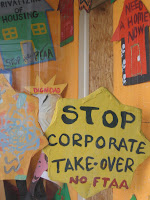As we look forward to this year's Lillian Smith Book Award Ceremony, scheduled for August 31, 2014, we also reflect on the moving presentations at the 2008 ceremony.
The first presentation was by Joseph Crespino, author of In Search of Another Country: Mississippi and the Conservative Counterrevolution.
In the 1960s, Mississippi was the heart of white southern resistance to the civil-rights movement. To many, it was a backward-looking society of racist authoritarianism and violence that was sorely out of step with modern liberal America. White Mississippians, however, had a different vision of themselves and their country, one so persuasive that by 1980 they had become important players in Ronald Reagan's newly ascendant Republican Party.
In this ambitious reassessment of racial politics in the deep South, Joseph Crespino reveals how Mississippi leaders strategically accommodated themselves to the demands of civil-rights activists and the federal government seeking to end Jim Crow, and in so doing contributed to a vibrant conservative countermovement. Crespino explains how white Mississippians linked their fight to preserve Jim Crow with other conservative causes--with evangelical Christians worried about liberalism infecting their churches, with cold warriors concerned about the Communist threat, and with parents worried about where and with whom their children were schooled. Crespino reveals important divisions among Mississippi whites, offering the most nuanced portrayal yet of how conservative southerners bridged the gap between the politics of Jim Crow and that of the modern Republican South.This book lends new insight into how white Mississippians gave rise to a broad, popular reaction against modern liberalism that recast American politics in the closing decades of the twentieth century.
Professor Crespino's presentation was followed by a moving presentation by Wesley Hogan, author of Many Minds, One Heart: SNCC's Dream for a New America.
Howdid the Student Nonviolent Coordinating Committee break open the caste system in the American South between 1960 and 1965? In this innovative study, Wesley Hogan explores what SNCC accomplished and, more important, how it fostered significant social change in such a short time. She offers new insights into the internal dynamics of SNCC as well as the workings of the larger civil rights and Black Power movement of which it was a part.
As Hogan chronicles, the members of SNCC created some of the civil rights movement's boldest experiments in freedom, including the sit-ins of 1960, the rejuvenated Freedom Rides of 1961, and grassroots democracy projects in Georgia and Mississippi. She highlights several key players--including Charles Sherrod, Bob Moses, and Fannie Lou Hamer--as innovators of grassroots activism and democratic practice.Breaking new ground, Hogan shows how SNCC laid the foundation for the emergence of the New Left and created new definitions of political leadership during the civil rights and Vietnam eras. She traces the ways other social movements--such as Black Power, women's liberation, and the antiwar movement--adapted practices developed within SNCC to apply to their particular causes. Many Minds, One Heart ultimately reframes the movement and asks us to look anew at where America stands on justice and equality today.
Join us for this year's ceremony.
Sunday, September 6, 2015
DeKalb County Public Library
Decatur, Georgia





